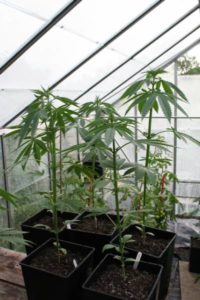 Many types of coverings are available to purchase for your greenhouse. Traditional greenhouses use glass for the windows, though not only being expensive, glass is heavy, easily broken, and not the best for security.
Many types of coverings are available to purchase for your greenhouse. Traditional greenhouses use glass for the windows, though not only being expensive, glass is heavy, easily broken, and not the best for security.
Other products that can be used in place of glass are plastics or fiberglass since plastics are much cheaper than glass, along with being very lightweight, and durable.
Greenhouses that use plastics can be heated just as effectively compared to the glass so plant growth and flowering production under plastic coverings are just as effective as glass coverings.
Fiberglass is lightweight, strong, and practically hail-proof so a good grade of fiberglass should be used because poor grades discolor and reduce light penetration. Use only clear, transparent, or translucent grades for greenhouse construction.
Tedlar-coated fiberglass lasts 15 to 20 years, but the resin covering the glass fibers will eventually wear off, allowing dirt to be retained by exposed fibers. A new coat of resin is needed after 10 to 15 years.
Light penetration is initially as good as glass but can drop off considerably over time with poor grades of fiberglass. Rigid double-layer plastic sheets of acrylic or polycarbonate are available to give long-life, heat-saving covers.
These covers have two (2) layers of rigid plastic separated by webs so the double-layer material retains more heat, and energy savings of 30% is common.
Acrylic Greenhouse Coverings

Acrylic is a long-life, non-yellowing material; the poly-carbonate normally yellows faster, but usually, is protected by a UV-inhibitor coating on the exposed surface. Both materials carry warranties for 10 years on their light transmission qualities and both can be used on curved surfaces; the polycarbonate material can be curved the most.
As a rule, each layer reduces light by about 10%, and about 80% of the light filters through double-layer plastic compared with 90% for glass. Film-plastic coverings are available in several grades of quality and different materials so generally these are replaced more frequently than other covers.
Structural costs are very low because the frame can be lighter and plastic film is inexpensive since light transmission of these film-plastic coverings is comparable to glass.
The films are made of polyethylene (PE), polyvinyl chloride (PVC), copolymers, and other materials. A utility grade of PE, which will last about a year and is available at local hardware stores.
Commercial greenhouse-grade PE has ultraviolet inhibitors in it to protect against ultraviolet rays; it lasts 12 – 18 months and copolymers tend to last 2 to 3 years.
New additives have allowed the manufacture of film plastics that block and reflect radiated heat back into the greenhouse, as does glass, which helps reduce heating costs.
PVC or vinyl film costs two to five times as much as PE but lasts as long as five years. However, it is available only in sheets four (4) to six (6) feet wide and it attracts dust from the air, so it must be washed occasionally.
Framework and coverings for the greenhouse are only the “tip” of the iceberg since there are many other components that are needed to make a successful greenhouse function properly. Growing in a greenhouse is often more demanding than growing indoors.
Let us know what you think.




Responses